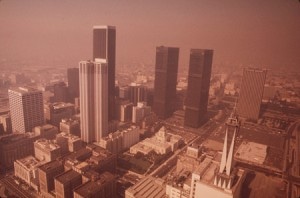Dec 19 2017
 A smoggy day in Los Angeles in 1973. Decades of efforts to reduce air pollution have led to cleaner air in Los Angeles and other U.S. cities. (Credit: Public Domain)
A smoggy day in Los Angeles in 1973. Decades of efforts to reduce air pollution have led to cleaner air in Los Angeles and other U.S. cities. (Credit: Public Domain)
According to a new research from Caltech, an imbalance between the trends in two common air pollutants is unpredictably activating the formation of a class of airborne organic compounds not typically found in the atmosphere over urban areas of North America.
For years, attempts to decrease air pollution have resulted in cleaner air in U.S cities like Los Angeles with subsequent progresses in public health. Those efforts have targeted both hydrocarbons and nitric oxides. Nitric oxide is a compound of oxygen and nitrogen discharged from engines (particularly those powered by diesel fuel) and from coal power plants. Hydrocarbons belong to the family of molecules made from linking together hydrogen and carbon. These molecules are discharged from many sources including trucks, gasoline-powered cars, cleaners used both at home and in industrial settings, solvents, and even trees.
One method researchers employ to track the varying rates of hydrocarbon emissions and nitric oxide emissions is by investigating the ratio of the levels of non-methane atmospheric hydrocarbons to those of nitric oxide (methane, a strong greenhouse gas, is tracked independently). From 1987 and 1997, that ratio fell by a factor of two.
Regulations aimed at enhancing air quality in urban areas like Los Angeles have made swift progress on minimizing hydrocarbon and nitric oxide emissions. As old cars have been removed from the street in support of cleaner new cars, and diesel trucks have been replaced or retrofitted, nitric oxide emissions have fallen rapidly. Compared to 1970 models, new trucks and cars create about 99% fewer common pollutants, according to the Environmental Protection Agency. During the last 10 years, for instance, the amount of nitric oxide in Los Angeles's air has reduced by half.
Air pollution regulations have also resulted in decreases in hydrocarbon emissions, but these decreases are slowing. Hydrocarbons form from many sources, making it harder to tackle them. For instance, these compounds are emitted by the two-cycle engines used in leaf blowers and lawn mowers—equipment that tends to remain in use longer than cars and is subject to fewer regulations.
The sharp reduction in nitric oxide levels compared to the slower drop in hydrocarbons is significant: according to a latest study led by Caltech's Paul Wennberg and the University of Copenhagen's Henrik Kjaergaard, this difference can cause the production of chemicals known as organic hydroperoxides.
Organic hydroperoxides are already present in nature. In rural and other areas lacking large quantities of engine exhaust – and as a result regions where the levels of nitric oxide are extremely low – the interaction of trees off-gas volatile organic compounds (VOCs) with sunlight can form the molecules.
The team guided by Wennberg found, however, that there is another chemical pathway for creating organic hydroperoxides—one that occurs at nitric oxide levels considerably higher than can be found in the atmosphere over deserted regions.
This is chemistry that does not exist in any of the models of how nitric oxide and hydrocarbons interact.
Paul Wennberg, Professor of Atmospheric Chemistry and Environmental Science and Engineering, Caltech
The atmospheric nitric oxide concentrations over Los Angeles and in urban areas across the country are at present dropping to the levels at which this process—known as gas-phase autoxidation—takes place.
Gas-phase autoxidation occurs when there are not sufficient nitric oxide molecules for hydrocarbons to react with. Consequently, hydrocarbon molecules react with themselves. Gas-phase autoxidation has been seen in other settings—for instance, the process can create skin-irritating organic hydroperoxides in some cosmetic items that have gone bad and causes wine to spoil and butter to go sour. But the researchers had thought that it could not happen in the atmosphere, given present urban nitric oxide concentrations. Wennberg and colleagues have learnt otherwise.
As these nitric oxide concentrations go down by another factor of two over the next five to seven years, we're going to start making more and more organic hydroperoxides in urban areas," Wennberg says. In the air, these hydroperoxides are known to form particulates—aerosols. "The problem is that we haven't seen large concentrations of hydroperoxides in heavily populated areas, so we don't know how the formation of gas and aerosol hydroperoxides will impact public health. But we do know that breathing in particles tends to be bad for you.
Paul Wennberg, Professor of Atmospheric Chemistry and Environmental Science and Engineering, Caltech
Wennberg and Kjaergaard's findings will be published online this week by the Proceedings of the National Academy of Sciences. The research paper is titled "Atmospheric autoxidation is increasingly important in urban and suburban North America." Wennberg's co-authors from Caltech include Brian M. Stoltz, professor of chemistry; graduate student Eric Praske; postdoctoral scholar J. Caleb Hethcox; and staff scientist John D. Crounse (PhD '11). Other authors of the paper include Rasmus V. Otkjær of the University of Copenhagen. This research was funded by the National Science Foundation and the University of Copenhagen.